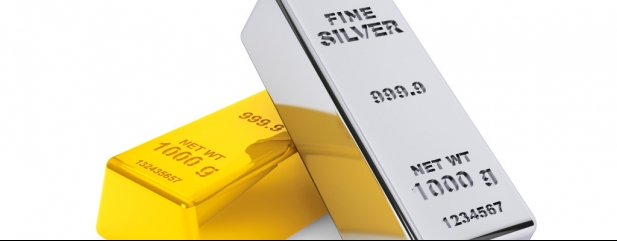Archived article
Please note that tax, investment, pension and ISA rules can change and the information and any views contained in this article may now be inaccurate.
The silver price is cheap relative to gold

The Silver Surfer was the creation of Marvel Comics legend Jack Kirby and the character acted as the herald of Galactus, the devourer of planets. This intergalactic super-being was usually fended off by the Fantastic Four or The Avengers.
From the point of view of investors, inflation devours wealth as scarily as Galactus consumed solar systems. Rather than turn to superheroes for protection against this potential threat, markets are turning toward something else known for being nearly indestructible, precious metals – principally gold and silver.
At the time of writing gold is setting new record highs above $1,900 an ounce but at $24 an ounce silver is still trading way below its prior peaks of 2011 and 1979, even if silver’s 34% year-to-date gain in 2020 outpaces that of gold by several percentage points.
PRECIOUS HAVENS
Precious metals tend to arouse strong feelings among investors. Some investors love them as a potential hedge against inflation, some against deflation and some against unforeseeable disasters and market dislocations, while others detest them, viewing gold in particular as a barbarous relic or inert useless lump.
But bulls are putting bears to flight right now and there may be three possible reasons why gold and silver are both doing well.
First, the market may be pricing in the almost unthinkable return of inflation, thanks to rampant central bank money creation through quantitative easing (QE) schemes, governments’ accumulation of ever-higher deficits, supply-side dislocation thanks to Covid-19 and possibly firms putting up their prices to help the meet the additional costs of staying in business in a post-pandemic world.
A five-year forward expectation for inflation of 1.67% in the US is hardly earth-shattering stuff, compared to the double-digit rates of the 1970s and early 1980s, but it does seem as if investors are becoming more wary of inflation.

Second, so-called ‘Austrian school’ economists do not define inflation by price changes, but change in money supply, relative to the volume of services and goods produced. The 24% year-on-year surge in US M2 money stock will have anyone who follows their theories on a state of high alert.
Third, related to the money supply, central bank money creation and higher government deficits could be driving fears of monetary debasement, prompting a rush to perceived havens and stores of value such as gold and to a lesser degree silver.
The US Federal Reserve has ramped up QE in 2020 in response to the pandemic, taking its total assets from $4 trillion to $7 trillion, through a series of programmes designed to buy a wide range of financial instruments.

Gold and silver surged between 2008 and 2011 as the Fed ran its first three rounds of QE but they then lost ground as it looked like the monetary authorities had regained control of the economic situation.
The pandemic may have changed all that, and the cost of keeping the show on the road this time around has already been much higher. One question that buyers of gold may already be asking themselves is what action will be taken by the Fed and other central banks next time a recession hits, as the system will feature even more debt and potentially be even more susceptible to an unexpected shock.
HOT STUFF
There is a fourth angle which pertains to silver only. Unlike gold, silver has industrial uses and as such is a more ‘cyclical’ play, because it is the best conductor of all metals and has antimicrobial attributes which make it a perfect biocide.
Demand from the traditional film photography industry is probably all but gone but these chemical properties means silver is ideal for the medical equipment, electronics, water purification and solar power industries.
As the world focuses more on renewable energy, solar panels could be a driver of silver demand. Whether this proves more potent than demand for a haven remains to be seen, but historical data does suggest silver is trading cheaply relative to gold.
The gold/silver price ratio has average 56 since 1970 but an ounce of gold currently trades at 80 times the price of an ounce of silver.

While the HUI Golds Bugs index trades below its average ratio to the metal price, silver miners do not look especially cheap compared to the physical commodity, based on the relationship between the metal and the Solactive Silver Miners index.
That benchmark has a fairly limited history and silver miners traded a lot more expensively relative to the metal in 2008 and 2011, so investors who prefer miners to metal still have much to ponder.
There is no guarantee that silver’s run will continue – if Covid-19 is beaten and the economy bounces back more strongly than hoped then the appeal of haven assets might not be anywhere near as strong.

Important information:
These articles are provided by Shares magazine which is published by AJ Bell Media, a part of AJ Bell. Shares is not written by AJ Bell.
Shares is provided for your general information and use and is not a personal recommendation to invest. It is not intended to be relied upon by you in making or not making any investment decisions. The investments referred to in these articles will not be suitable for all investors. If in doubt please seek appropriate independent financial advice.
Investors acting on the information in these articles do so at their own risk and AJ Bell Media and its staff do not accept liability for losses suffered by investors as a result of their investment decisions.
Issue contents
Editor's View
Feature
First-time Investor
Great Ideas
- Kainos up 50% since we said to buy, helped by knock-out trading update
- Our ‘buy’ call on resilient Texas Instruments gets off to solid start
- Coca-Cola shares are trading at a rare bargain level
- Recent share price dip is nothing to worry about with Tristel
- Keep buying AG Barr as latest update is very encouraging
- Knights set to lure top lawyers and their clients from rival law firms

 magazine
magazine








